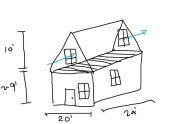









 1
1




Owner, Etta Place Cider








Starting on developing a 10 acre permaculture homestead in a sub-urban area. see http://www.my10acres.info








we don't have a problem with lack of water we have a problem with mismanagement
beavers the original permies farmers
If there is no one around to smell you ,do you really stink!




Ann Torrence wrote:I am a complete convert to Harvey Ussery's view that birds need wind protection and to be kept dry, but not necessarily insulation. In fact, that insulation can result in dampness that creates more problems than it solves. Birds get sick from dampness and confined quarters.
My project thread
Agriculture collects solar energy two-dimensionally; but silviculture collects it three dimensionally.




Willing to find out what 'impossible' means.




My project thread
Agriculture collects solar energy two-dimensionally; but silviculture collects it three dimensionally.











"...specialization is for insects." - Lazarus Long
Universal Introduction to Permies
How Permies.com works
 1
1




Emily Wilson www.blarnyardgarden.blogspot.com
"The point of life is dinner."
- Adam Gopnik





List of Bryant RedHawk's Epic Soil Series Threads We love visitors, that's why we live in a secluded cabin deep in the woods. "Buzzard's Roost (Asnikiye Heca) Farm." Promoting permaculture to save our planet.

|
After three months of being pooless the hair and skin on this tiny ad is glorious!
The new kickstarter is now live!
https://www.kickstarter.com/projects/paulwheaton/garden-cards
|





